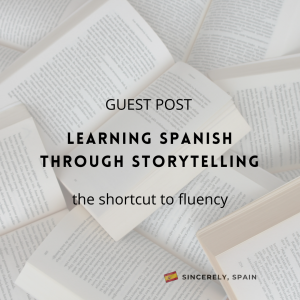
Learning Spanish through storytelling: the shortcut to fluency
Dear Rafa,
 Today on the blog we are sharing with you a blog post from Marta Fernández, a native Spanish teacher and coach. After experiencing the cultural and linguistic barriers for over a decade as an expat in Bristol, UK, she returned to Madrid with the mission of helping expat women to communicate, integrate and feel connected in Spain. She provides language and cultural teaching and coaching to minimize the effects of the cultural shock and facilitate a smooth transition to Spain.
Today on the blog we are sharing with you a blog post from Marta Fernández, a native Spanish teacher and coach. After experiencing the cultural and linguistic barriers for over a decade as an expat in Bristol, UK, she returned to Madrid with the mission of helping expat women to communicate, integrate and feel connected in Spain. She provides language and cultural teaching and coaching to minimize the effects of the cultural shock and facilitate a smooth transition to Spain.
You can find more about Marta on her website: https://spanishflowschool.com/
Or her Instagram: @marta.spanish.teacher
And with that, we hope you enjoy this article about language learning, we know we did:
Introduction
You live in Spain, you know some Spanish but when it comes to interacting with the locals you feel small and insecure…
Suddenly, it seems that achieving fluency in Spanish is like an uphill task. You thought that after living in Spain for a while your language skills would have been better. You start thinking that Spanish is so difficult or that you’re not good enough or too old to learn languages… But let me tell you! None of these are likely to be the case.
In this article we’re going to explore what the key elements are that make your language process successful as defined by neuroscience, and how teaching fluency through Storytelling could be the perfect approach to accomplish this goal.
ACQUIRING VS LEARNING
First of all, we need to understand the differences between Acquiring Vs Learning a new language.
| LEARNING A LANGUAGE | ACQUIRING A LANGUAGE |
|
|
Our ultimate goal will be to acquire a language.
We don’t want students to be learning things about the language, (like lists of rules and exceptions or lists of vocabulary out of context).
Because, knowing the theory about the language doesn’t mean that you will be able to speak fluently and spontaneously.
It’s like knowing the theory of how to dance a Tango. This doesn’t mean that you will be able to jump onto the dance floor and start doing it. You will need a lot of practice to internalise the moves until you start dancing fluently by feeling the rhythm of the music. Following this analogy, when learning a language we want to be able to speak it because we feel it, because it sounds right and we have internalised it.
If during the class time learners are mostly exposed to explicit grammar explanations, they will understand linguistics, the reasons and rules of why structures are how they are. This can be useful for students who are interested in linguistics, but it won’t be useful to reach fluency and to start communicating in Spanish.
Often, people who learn languages with grammar-based methodologies tend to overthink structures , translate as they speak or get frustrated when they don’t get verb-endings right, resulting in poor fluency and confidence.
A better way of learning languages: TPR Storytelling
TPRS stands for Teaching Proficiency Through Reading and Storytelling.
It’s a technique developed by a Spanish teacher, Blaine Ray, in the late 80s inspired by the work of Dr. Krashen and Dr. Asher.
This methodology is based on the idea that we need to be constantly exposed to comprehensible input in order to acquire a new language.
 Through storytelling we present the language in the context of a story. The teacher starts with the outline of a story and asks students questions that are strategically designed so learners are prompted to use different verb forms and tenses. This enables them to decode the structures of the language naturally.
Through storytelling we present the language in the context of a story. The teacher starts with the outline of a story and asks students questions that are strategically designed so learners are prompted to use different verb forms and tenses. This enables them to decode the structures of the language naturally.
The main goal when using this technique is the development of proficiency using contextualised, repetitive, varied and comprehensible input input that maintains learners’ interest.
Teachers using TPRS are often checking students’ comprehension and making the stories personal, relevant and captivating to them.
Key ingredients that according to Neuroscience make language learning more efficient and how TPRS is the perfect fit!
Ingredient 1: Stress-free atmosphere
When we learn a language a key factor is to feel safe and calm during our learning journey.
 If we feel pressured to speak when we’re not ready or we feel insecure and self-conscious our limbic brain (the emotional brain) will take over our thinking brain, creating mental blocks.
If we feel pressured to speak when we’re not ready or we feel insecure and self-conscious our limbic brain (the emotional brain) will take over our thinking brain, creating mental blocks.
This is not necessarily because you don’t know the words, but this is because your emotions (like anxiety, self-doubt, self-consciousness) are paralysing you.
That’s why it’s crucial that your learning environment promotes safeness, it’s enjoyable and that you feel comfortable and at ease in the classroom.
How TPRS promotes a stress-free atmosphere
- Learners produce output when they’re ready. When using TPRS learners aren’t forced to speak rapidly, because we understand that if we provide enough exposure to comprehensible input, they will spontaneously speak when they have internalized the structures and words.
- Mistakes are corrected by giving more input. The way we approach mistakes is simply by providing more input and repetitions of the correct structure as soon as possible after the mistake has been produced. We understand that grammar accuracy will come with time and constant exposure to the language. The same way as we do with our first language.
- Only comprehensible input is given. When students can understand what is being said during the class, they become more focused and engaged and the affective filter is lowered.
Ingredient 2: relevant, real and personal language
An adult’s brain is selective, it checks out the relevance and the importance of the language and its practicality.
If we learn words and structures that aren’t relevant to our needs or context, our brains won’t keep them long-term. We will only remember the words that we can use and apply in our real lives.
When learners are sitting in a classroom passively receiving input and doing exercises that aren’t aligned with their interests or that aim to “describe” the language (gap-fill activities focused on the form of the verbs rather than on the meaning), they are just learning things about the language, as opposed to engaging and producing meaning with the language.
How TPRS provides relevant and personalised language
In the early stages, TPRS focuses on the words and verbs that are more frequently used. For example, for someone who is studying Spanish from scratch we will introduce first the Super Seven verbs, which are tiene, es, está, quiere, hay, le gusta, and va. These are the verbs that appear in multiple contexts and therefore, learners will be able to recognise and use them easily. Once the learner has achieved fluency using these verbs, we will gradually introduce more: the Sweet 16 Verbs.
In order to provide more input to create stories, but still making sure of staying in bounds (ensuring that our class is fully comprehensible), teachers use cognates (words that are similar in the mother and target language of the student), proper names or synonyms.
At the same time, we use personalized questions and answers (PQA) to create the stories. This will make memorable and meaningful input for the student, and promote long-term acquisition.
If in contrast, we just learn generic Spanish following a generic syllabus, it will take us longer to acquire and internalize structures. A generic syllabus doesn’t prioritize students’ needs, but grammar structures and topics that make sense from a linguistic point of view.
 Ingredient 3: positive emotions
Ingredient 3: positive emotions
According to neuroscience, emotion assists learning and the formation of memory. Emotion can grab our attention and also can activate the amygdala. The amygdala, as part of the emotional brain, reacts according to the emotional response.
If the learning experience is fun and positive, we are facilitating the right ingredients to maintain learners’ motivation and the effectiveness of memory encoding will be enhanced.
How TPRS promotes positive emotions
Stories in TPRS include dramatization and exaggeration to make them fun and interesting in order to captivate students.
Often the characters and plots have details and humorous twists to make them more engaging and fun. The goal is to maintain students’ attention and to promote a safe and relaxed atmosphere.
Ingredient 4: Motivation
 Motivation is essential to keeping dopamine flowing during the learning process.
Motivation is essential to keeping dopamine flowing during the learning process.
TPRS combine all the right ingredients to keep students motivated.
When the class is captivating, personalised, fun, comprehensible and students don’t feel anxious or self-conscious about making mistakes, motivation is enhanced.
When learners feel that they can contribute to the stories and generate their own output, they become more invested and acquisition of the language happens quicker and seamlessly.
You might be wondering… how does TPRS approach grammar?
We said above that we limit vocabulary in early stages to provide relevant and frequently used words and verbs, but with TPRS grammar isn’t limited. As opposed to traditional methodologies, when using TPRS, the past tense is introduced almost at the same time as the present tense.
Grammar features are presented in the context of the story and the teacher provides lots of repetitions. In order to make sure that grammar is being understood we do “grammar pop-ups”, which are very short (5 to 10 second) grammar explanations
In conclusion, TPRS presents a way of teaching languages and provides all the ingredients that – in accordance with neurolinguistics – promote long-term acquisition of the language: stress-free atmosphere, personalized, real and relevant language, positive emotions and it keeps motivation high throughout the process.
 References:
References:
Ray, B. & Seely, C. (2008) Fluency through TPR Storytelling. Achieving real language acquisition in School. Berkeley, CA. Command Performance and Language Institute.
Paling, R. (2016) Language Coaching certification. Tarragona. Efficient Language Coaching Global SLU.





2 Comments
Meg Shirey
Where can I start this learning experience
Sincerely, Spain
Dear Meg,
We suggest connecting with Marta on Instagram: @marta.spanish.teacher
Best of luck with your language journey!
Sincerely,
Dani and Claudia